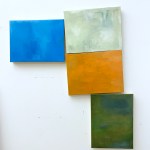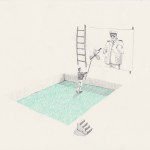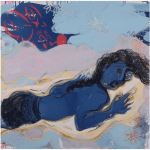Guest contributor Eileen Jeng / The exhibition “The Still Open Case of Irving Petlin: From the Years 1960 to 2012“ at Kent Fine Art comprised a selection of the artist�s paintings and pastel drawings spanning over five decades. After World War II, Petlin moved away from the bold aesthetic sensibilities of the Chicago Imagists and the Monster Roster, which included an older generation of Chicago artists such as Leon Golub and Nancy Spero, towards a more surrealist approach. He developed a penchant for creating allegorical works, informed by his personal experience, historical and current events, mythology, Biblical stories, and literary writings. With an idiosyncratic approach, the 80-year-old artist creates unsettling yet imaginative, thoughtfully executed works.
[Image at top: Installation view. All images courtesy Kent Fine Art]
Over a career that began in Chicago in the 1950s, Petlin also worked in Paris and New York, where he currently lives, spending summers in Martha�s Vineyard. He also had stints in San Francisco and Los Angeles for teaching appointments, military duty, and anti-Vietnam War activism. The dark-walled, dimly-lit front gallery at Kent Fine Art housed a re-creation of Petlin�s studio in Paris in 1960 � a desk and table with buckets of coated paint brushes. The installation also included two early paintings and Table of Heads (1974-2011), a multi-part piece consisting of 20 enigmatic portraits on canvas, arranged tightly on a table. In these small paintings, the influence of French symbolist Odilon Redon was evident; the large-scale paintings in the main gallery evoked Belgian artist James Ensor and Chilean surrealist painter Roberto Matta.
In the diptych The Eleventh of January (2009), which was previously titled Gaza/Guernica, Petlin depicts the tragedies of war, particularly attacks on defenseless civilians like, as suggested in the early title, those that have occurred in the Palestinian territories and the 1937 bombing of the Spanish city during the Spanish Civil War. The notes next to the painting, however, only focus on Gaza. With figures painted in bold colors in the foreground, mere outlines of a mass of people in the background, and strokes and splotches of red and orange paint resembling blood and fire, Petlin leaves the viewer to fill in the rest of the story. Perhaps he changed the title to leave the work open to broader and more contemporary interpretation, as the title of the exhibition seems to indicate.
In the large-scale work Hebron (1998-2001), Petlin utilizes chalk and oil on unprimed linen to create outlines of figures and smears of red paint and chalk, indicating bloodshed. Petlin�s works are powerful and emotive. From some referential elements, one can determine the subject matter–for instance, the Cave of the Patriarchs Massacre of Palestinian Muslims in the mosque in 1994; the city of Hebron is a site of continuing conflict today.
Petlin often depicts or alludes to water. Elusive early paintings, such as R�volution Pastorale (1978-1981), provide a seemingly idyllic memory (after the Vietnam War, according to the notes) with ancient spiritual figures on the bank of a river. Motifs, such as the corner of a stretcher bar, from his earlier series �Rubbings from the Calcium Garden� also appear in this work.
 Abandoned Forest (Broken Boat), 2012, pastel on handmade paper, triptych, overall: 34 5/8 x 82 5/8 inches.
Abandoned Forest (Broken Boat), 2012, pastel on handmade paper, triptych, overall: 34 5/8 x 82 5/8 inches. In Petlin�s pastel drawings, specific events and places are not as decipherable as they are in his paintings unless there is a titular reference. In the three-part pastel work on handmade paper Abandoned Forest (Broken Boat) (2012) and the diptych Morning of the Other Window II (2007), Petlin utilizes recurring imagery of a boat, forest, and cottage. In the former, a broken boat is lodged into the trees on one side of the work, while small, ghostly white figures are wandering on the opposite side. In Morning of the Other Window II, there are animal-like but not human figures, in contrast to Petlin�s other works on paper and paintings in the exhibition. Even so, the human presence is implied with the warm glow of light in the cottage window. Figures appear and disappear in Petlin�s work–a poignant reminder of our mortality.
As the title of the show suggests, there is still much to be discovered in Petlin�s intriguing, complex, and multi-layered work.
“The Still Open Case of Irving Petlin: From the Years 1960 to 2012,” Kent Fine Art, Chelsea, New York, NY. November 8 � December 20, 2014.
——
Two Coats of Paint is licensed under a Creative Commons Attribution – Noncommercial-No Derivative Works 3.0 United States License. For permission to use content beyond the scope of this license, permission is required.




















